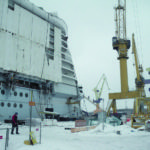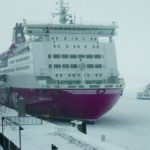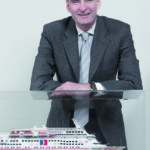Few shipbuilders would claim to be comfortable with the outlook for business over the next two or three years. Widescale over-ordering in virtually every ship sector propelled prices to record levels and set the scene for a spell in which virtually no new contracts were signed. Even shipyards with plenty of work in hand are vulnerable: owners who ordered »on spec« are finding their formerly secure funding sources drying up, as banks and finance houses seek to reduce their exposure to over-priced shipping assets.
Some shipbuilders have been hit harder than others and some northern Europeas specialist yards are now facing dire prospects unless[ds_preview] new deals can be negotiated and signed within the next few months. At STX Europe, for example, with headquarters in Oslo, 16,000 employees and 15 shipyards in Finland, France, Norway, Romania, Brazil and Vietnam, some of the company’s yards have virtually no work in hand. The trickle of lay-offs so far could turn into a flood by the end of this year unless the situation changes very soon.
Martin Landtman is Chief Executive of STX Finland Oy which comprises three highly specialised yards and a workforce of some 4,000, with roughly the same number of people working as subcontractors and suppliers. The company specialises in building cruise ships at its Turku yard – amongst them some of the largest and most spectacular ocean structures ever built – and has roughly a 20 % share of this market. At its Rauma facility, it builds cruise ferries and has a market share of around 40 %. STX Finland is also the world’s largest builder of icebreakers.
The company’s Turku yard, with a drydock measuring 365 m by 80 m, is now busily engaged in the outfit of Royal Caribbean’s Allure of the Seas, a sister vessel to the widely acclaimed »Oasis of the Seas«, which delivered to her owner last October. The »Allure of the Seas« will be commissioned at the end of November in time to start cruising early in December.
The two ships are the world’s largest – 225,000 gross tons – and each have capacity to carry the equivalent of a small town on two principal itineraries, both Caribbean based, where each ship is effectively »the destination.« The ships have cost around € 2 billion and taken 12,000 man-years to build. They are so large that when drydockings fall due at the end of their five-year docking cycles, there is no facility in the Americas with docks large enough to take them. They will have to sail to Europe or elsewhere to find drydocks with appropriate dimensions.
In Turku, around 1,200 workers have already been laid off on Finland’s generous state-backed terms and although the Allure of the Seas is currently a hive of activity, it is only a matter of months until the shipyard runs out of work completely.
Landtman must be worried, but if so, he is putting on a brave face. New ships, demonstrating greater innovation and cost efficiency, will of course be needed, he says. »We are in the field of specialised tonnage and we benefit from being part of the the STX Business Group.«
Diversification is a key strategy being followed at all three of the company’s shipyards. Offshore vessels, research craft, naval units and other specialised ships are all target markets.
But Lnadtman believes the cruise sector may have reached the bottom. Letters of intent have been signed for three new large vessels, Landtman points out: »it could be the beginning of the recovery.« However, the recent level of newbuilding activity is unlikely to be sustained once the recovery comes. Cruise demand in the major US market and amongst European cruise-goers will continue to increase, he believes, but a slowdown in growth should be expected. Instead of ten or twelve new ships each year, he thinks that newbuilding activity will come down.
But in the short run, Landtman is under no illusions. »The fight is now on to see which yards will survive,« he says, »and we intend to be among them. We must make sure we are ready when demand returns.«
The STX Finland Chief Executive also believes that the outlook for other key sectors in which the company is involved could start to improve before long. Its shipyard in Rauma, for example, focuses on cruise ferry construction and, whilst this sector has not escaped the downturn, demand for new ships has been delayed, he says, because of a 25–30 % downturn in cargo volumes. However, it is a specialised sector in which there is no real overcapacity. »Demand will recover because new ships are needed,« he says.
Indeed, negotiations on new contracts are already under way, and STX Finland is thought to be tendering for new cruise ferry contracts currently being mulled over by Viking Line. But with hardly any new ships having been ordered recently and relatively few new contracts in the offing, it is believed that Asian yards have come in with particularly competitive prices, making it even tougher for the Finnish yards to compete.
For STX Finland, the focus is on building ships that are operationally more efficient. Its cruise ferry designs, for example, are up to 50 % more efficient in energy consumption. The Oasis of the Seas and her sister Allure of the Seas, meanwhile, both have a 25 % smaller carbon footprint per passenger, partly as a result of their sheer size but partly also because of design innovation introduced by the Finnish shipbuilders.
»It is a mistake to believe that the world will stay the same,« Landtman opines. »Each yard must find its own solution.«
Viking Line orders could go east
Hungry Asian shipyards are competing fiercely for an imminent ropax order, probably involving two ships of around 60,000 gross tons, from Scandinavian ferry operator Viking Line. Altogether some nine yards were invited to tender for the ships and Viking Line president and chief executive Mikael Backman notes that there has been considerable interest shown from Asian yards, notably in South Korea but also elsewhere in the region although the chief executive declined to name names.
Market sources believe that a couple of yards in China are likely to have been on Viking Line’s list but this could not be confirmed. However, the fact that Asian yards are offering meen prices for this relatively specialised type of construction is likely to come as a disappointment to European builders as ferry-building is traditionally the preserve of a handful of specialist yards in Europe.
Backman notes that newbuilding prices have fallen significantly in recent months and now would therefore be a good time to order the new vessels, likely to be some 40 % larger than the 2,500-passenger 22-year-old Amorella and the 21-year old »Isabella« which will be phased out when the new ships deliver, probably in 2013. The ships operate on the route linking Turku, Mariehamn and Stockholm.
According to Backman, shipbuilders’ price ideas were being submitted to the company in early March. Viking personnel are busily working on plans for the new ships’ design which will incorporate various energy-saving features, including pod propulsors which, Backman says, should increase energy efficiency per passenger by more than 30 %.
Fierce behind-the-scenes lobbying is almost certainly taking place in Finland’s coridors of power. STX Europe’s Finnish yards in Turku and Rauma badly need new contracts – the Turku facility will run out of work when the Allure of the Seas delivers to Royal Caribbean in November unless new contracts are signed in the meantime. Some 1,200 workers have already been laid off by the company and the future of the remaining 2,200-strong workforce is very uncertain.
STX Europe is on Viking Line’s yard list but market sources question whether the relatively high-cost Finnish shipbuilder can compete with keen prices from yards in Asia. European regulations prevent any direct fiscal assistance in the form of subsidies but Finnish politicians are almost inevitably assessing whatever indirect support they can muster to keep the valuable contract at home.
Sulphur a burning issue for Finns
Finland’s shipping policy makers are not taking Marpol Annex VI lying down. New sulphur emission limits in the Baltic, North Sea and English Channel sulphur emission control areas (SECA) threaten to saddle a number of countries with massive extra fuel bills. And Finland is one of them. Industry estimates put the possible increase in freight costs as high as 50 % and this could affect as much as 90 % of Finland’s trade, most of which moves by sea across the Baltic.
As things stand, heavy fuel oil used by ships trading in SECA regions must contain no more than 1.5 % of sulphur. This falls to 1 % on July 1st this year and will be reduced further in 2015, to just 0.5 %. In contrast, vessels trading elsewhere in Europe can continue to use 1.5 % sulphur fuel, whilst outside of the European Union, ships can use fuel with sulphur content up to 4.5 %.
Not only does this make complicate bunker management on board ships trading regularly inside and outside SECA areas, it also penalises ship owners who trade in these regions and must pay more for low-sulphur fuel. Baltic Sea ferry companies, for example, will have to burn low-sulphur fuel permanently, thereby incurring substantial additional fuel bills.
Meanwhile, bunker experts point out that cruise lines, for example, which operate their ships on schedules which take in SECA ports in the north, other European terminals in the Mediterranean, for example, and popular destination ports outside of Europe, could now have to carry three grades of fuel.
An official letter has already been sent by Finland to the Secretary General of the IMO pointing out that the new rules on sulphur emissions discriminate against northern countries. The Finns have requested that the emissions targets be delayed, with an easing of targets perhaps to a 1 % maximum sulphur content level, rather than the 0.5 % envisaged in five years’ time. Besides Finland, other countries including Estonia, Lithuania and Sweden are thought to be assessing a similar strategy involving an approach to the IMO whilst Germany and Poland are also believed to be unhappy with the proposed regulations.
According to Olof Widén, managing director of the Finnish Shipowners’ Association, the new sulphur rules will mean that Finnish industry will face a hike of no less than € 840 million a year in extra fuel bills, with potentially devastating effects on the country’s paper, metal and mining sectors. He describes ten countries, including Finland, as »sulphur locked«, meaning that all of their sea trade must be transported through waters where low sulphur rules apply.
Three other countries – France, Norway and the UK – are hybrids, with part of their coastlines falling within the SECA, and part outside. Meanwhile Widén points out that under United Nations Law of the Sea provisions, Russian vessels can continue to trade within the SECA without complying with the new rules because the country has not ratified the convention.
There are therefore a whole range of anomalies across Europe, Finnish shipowners point out, with countries in the south virtually unaffected by the new emissions regulations. Some even believe that low sulphur fuel in the north could act as a disincentive for some ship owners to trade their ships in the region, with some shippers possibly even preferring to tranship their cargoes in the south and use road or rail to ship them to destinations in the north. This, they point out, would fly directly in the face of European initiatives to boost short-sea shipping and get more cargo off the roads and moving by sea.
New bulkers for Bore?
Fuel economy is likely to play a major role in the choice of ship design when Finnish shipowner Bore decides to sign up for new bulker tonnage for operation in the Baltic. According to senior executive vice president Thomas Franck, the company’s 15,000 dwt »Bravadan«, now 31 years old, could well be replaced with a couple of slightly larger 20–25,000 dwt vessels capable of trading across the Baltic in key trades including iron ore, limestone and coal.
There is significant demand for ice-class bulkers in northern Finland, Franck says, where much of the country’s industry relies on raw materials shipped on relatively short Baltic routes. At present, the company is engaged in design discussions with shipyards in Asia and Europe and Franck envisages that if contracts are signed soon, the »Bravaden« could be replaced by the end of 2011.
The company operates a fleet of some 20 vessels including roro’s, general cargo ships and three car carriers, converted from roro’s and now chartered to United European Car Carriers (UECC). It has two new »roflex« vessels under construction at Flensburger Shipyard in Germany costing € 110 million and when these 2,900 lane-metre ships deliver next year, they will replace the existing twin-engined 9,700 dwt »Estraden», built 1999 and relatively heavy on fuel, and the company’s 1977-built »Borden«, 6,500 dwt, which was re-engined in 2005.
Both of these vessels are currently on charter to Mann Lines of the UK. When the new roro’s are commissioned in May and August next year, they will be employed by the same charterer. Mann Lines is taking the two new ships on five year timecharters, with options.
Finnish fuel efficiency for new bulker designs
Finnish ship design group Deltamarin is promising potential customers dramatic fuel savings in new designs which it is now marketing for two bulk carrier types – a 37,000 dwt handysize vessel and a larger 64,000 dwt supramax. The company is working closely in the marketing of the new designs with French sale and purchase broker Barry Roliano Salles. It is also engaged in negotiations with a number of carefully selected shipyards which, in due course, could be licensed to build new vessels.
The company’s naval architects are not about to reveal any sensitive design secrets. But they do predict that the so-called
B.delta37 handysize, which will probably be able to lift 40,000 t of cargo and will have a cubic capacity of 50,000 m3, will burn just 18 t a day at a service speed of 14 kn. The larger B.delta 64 will be capable to carrying 64,000 t, will have a capacity of 78,000 m3, and will burn 25.5 t of fuel at a speed of 14.5 kn. Both vessels will therefore burn around 50 % less than corresponding units in these size ranges.
How have such dramatic efficiency improvements been achieved? Well, explains Juha Hanhinen, Project Manager at Deltamarin, the company’s designers focused on reducing hull resistance, improving interaction between the hull and the propeller, improving the engine specification and simplifying form so that the vessels should be easier and cheaper to build. There is no bulbous bow and a relatively full hull form – the block coefficient is 0.88 – giving more displacement with the same dimensions. Meanwhile a larger-than-usual propeller will turn more slowly, thereby providing propulsive efficiency improvements, he says. The vessels will also feature the company’s own rudder design.
Early in March, the design company was awaiting price feedback from its selected yards, all of which were asked to sign suitable non-disclosure agreements on the new designs before details were made available. However, Hanhinen was not expecting a premium on typical prices prevailing today. He points out that the engines are likely to cost a little more than usual, but the ships’ structures will be some 10 % lighter for the same payload and easier to build.
Meanwhile the company is heavily engaged in offshore oil and gas design projects. Although this sector of the market has been slow for the last couple of years, higher oil prices are generating new activity in a range of offshore vessels types, including pipelayers, semi-submersibles, construction vessels, FPSOs, FDPSOs and floating liquid natural gas plant.
The company expects that there could be as many as 40–50 FPSO projects over the next five years and although there are plenty of suitable tanker hulls available for conversion, some of the larger units for locations off West Africa, for example, are likely to involve newbuildings. Meanwhile, there has been less of a requirement for FPSO mobility than was first thought, according to Deltamarin. Field lives have been greater than expected and many units have therefore remained on station for longer than originally thought.
Paul Barlett
























